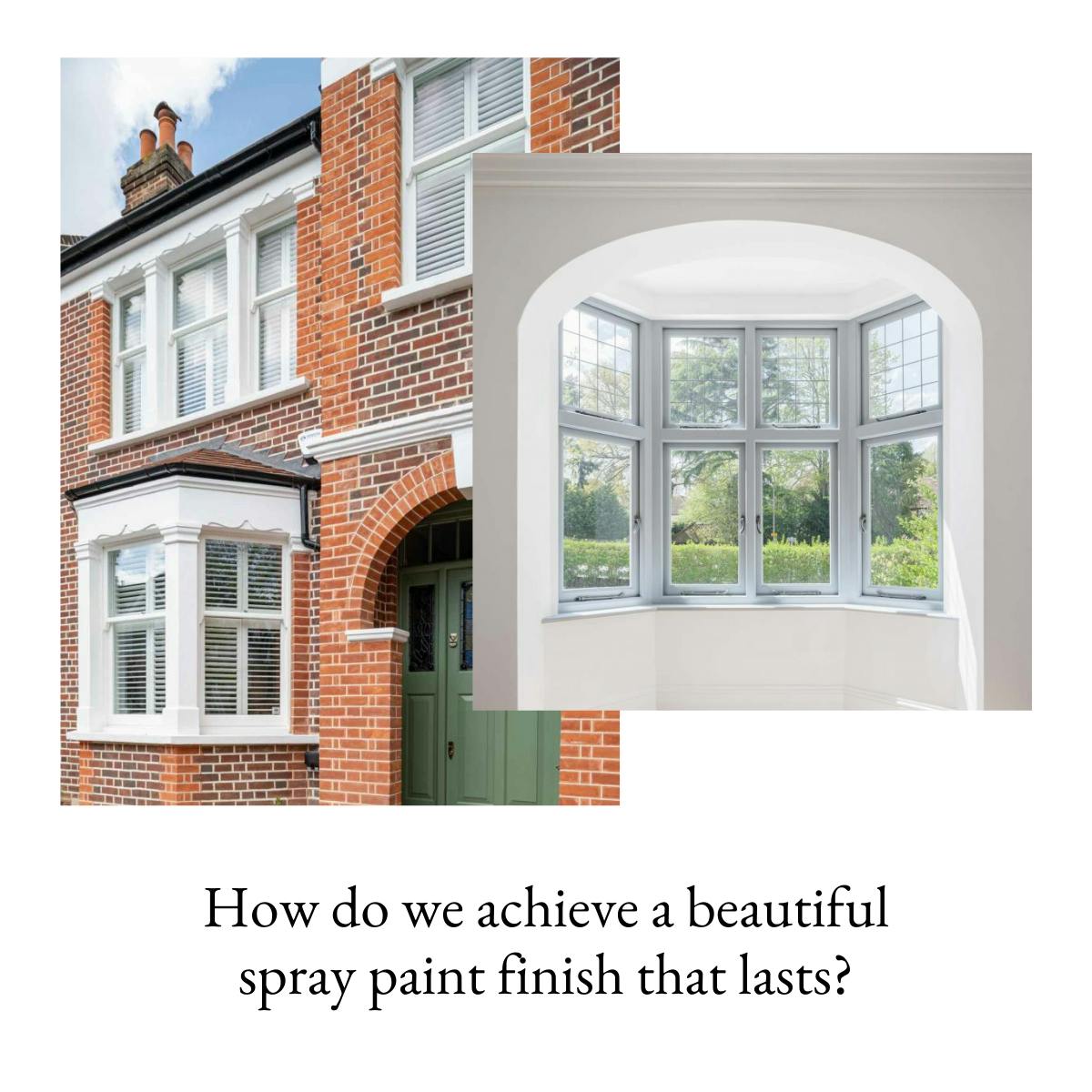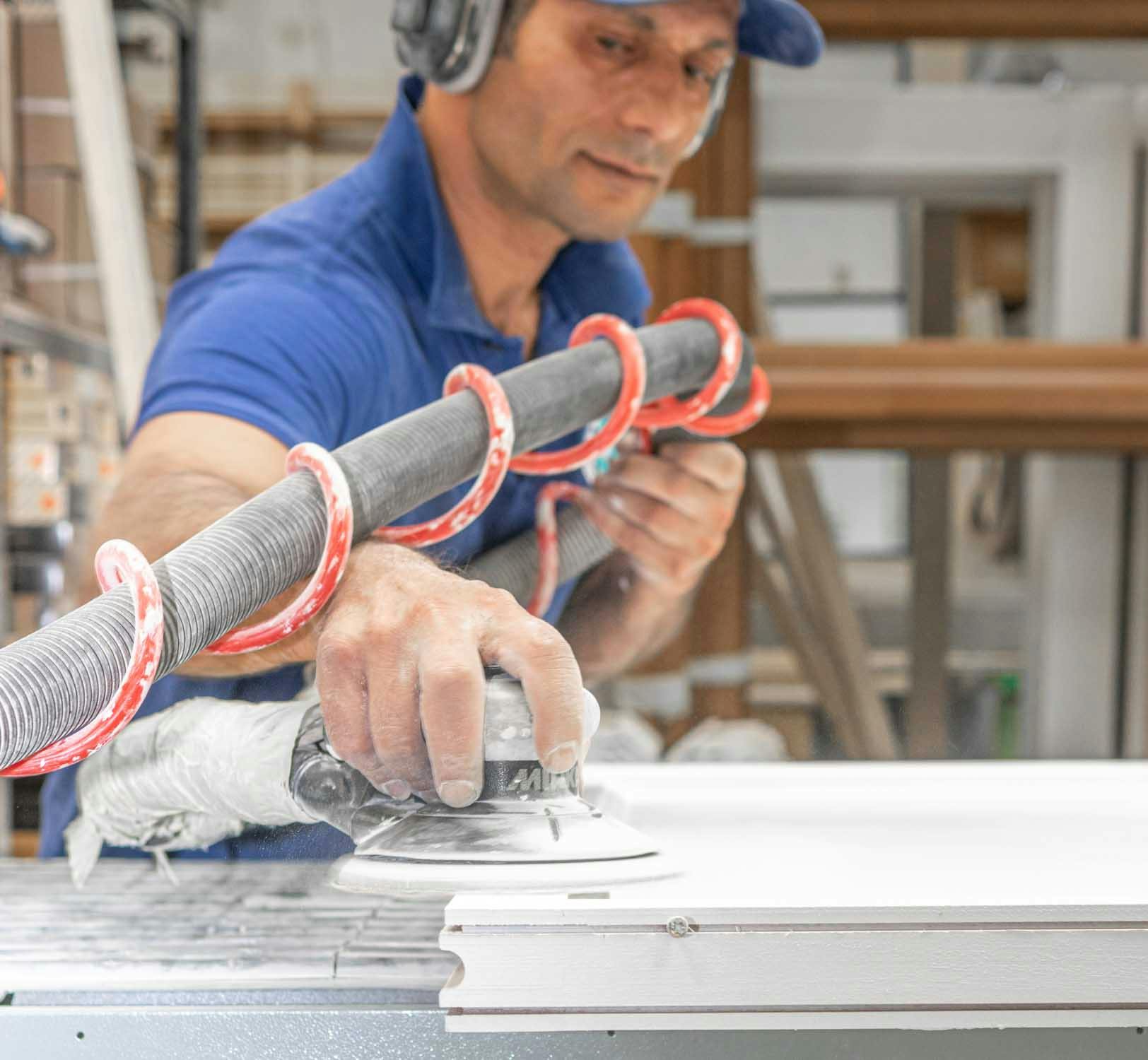
How We Paint Sash Windows and Doors
At Todi & Boys, our painting process for wooden sash windows and doors ensures a flawless finish. When it comes to painting window frames, we focus on the finer details that make a significant difference in the end result.
When painting wooden window frames, we sand the timber multiple times to prepare it for the painting process. We then apply two coats of primer to create a solid base for the topcoat. Each undercoat is carefully sanded with fine-grit sandpaper to achieve a smooth finish.
Our unique approach involves painting the final topcoat with the glass still in place, which is often considered unconventional. However, this method ensures a paint seal, preventing water from seeping in and causing damage, making the double glazing more durable.
To protect the glass during the final topcoat application, we meticulously mask it off, just like a decorator would. We then spray the final topcoat.
Lastly, we conduct a thorough quality check. If any window or door doesn’t meet our stringent standards, we apply one final topcoat after filling and sanding the necessary areas.
When it comes to painting window frames and French doors, our process goes beyond the basics to deliver exceptional results. With our expertise in spray finished windows, we ensure your wooden sash windows and French doors receive the care and attention they deserve, resulting in a beautifully painted finish that lasts for years to come.
What We Use To Paint Windows and Doors
What’s the best paint for doors and windows?
We use water-based, micro-porous paint that has multiple benefits over oil-based paint.
We believe that it’s the best paint for windows and doors as it’s a lot thinner and is sprayed on in a workshop under a controlled environment to achieve a beautiful finish that provides greater protection against the elements.
Microporous paint is the best paint for external joinery because any water inside the wood can escape rather than stay inside the wood. If the water is unable to escape it can rot, shrink, swell, bend or get jammed from the inside.
With micro-porous spray finished windows, the timber can breathe. Water and moisture passes out (but not in) through the paint when the weather is warm, meaning there’s minimal damage which would lead to you repainting your sash windows.
Why is a satin finish good for windows?
According to an old wives’ tale, if you have glossy windows, it protects against the weather more.
This most probably came from the fact that the glossier the window was back in the day, the more oil content it had, which made it potentially last longer.
But this isn’t true. Modern paints can be applied gloss or satin, depending on what you prefer.
When painting sash windows and doors we only use satin paint because it has a nicer, cleaner finish and fits in better with the character of period properties.
The Benefits of Painting Wooden Windows and Doors
There are a number of benefits to painting windows and doors. These include:
Increased protection against the elements
Painting windows and doors with high-quality micro-porous paint provides a protective barrier against weather elements, such as rain, snow, and sunlight, preventing premature wear and deterioration of the wood.
Reduced rotting
Properly painting doors and windows with the right type of paint and primers can help safeguard the wood from rot and decay, prolonging their lifespan.
UV protection
Certain types of paint offer UV protection, shielding the windows and doors from harmful ultraviolet rays that could cause fading or damage.
Customisation
Painting wooden window frames allows you to choose from a wide range of colours and finishes, enabling you to customise the appearance of your windows and doors to match your home’s style and decor.
Improved resale value
A beautifully painted exterior with well-maintained windows and doors can increase the resale value of your home, making it more appealing to potential buyers.
Improved energy efficiency
When using the right paint and techniques, painting windows and doors can help improve insulation and reduce energy loss, contributing to better energy efficiency in your home.
How to Maintain your Paint Finish and Redecorate
When you think about repainting your windows every 4 to 6 years, you probably think, ‘I need to take the paint back to the timber to do it properly.’ In actual fact, because we’ve done so much work in our workshop, this isn’t the case at all.
You only need a fine-grit sanding sponge to take off any dirt that’s stuck onto the paint, fill in any chips, cracks or dents and lightly apply another coat of micro-porous paint with a brush.
(You can also DIY some of the filling of window and door cracks, check out the maintenance page here)
Because this paint is thinner, it shouldn’t affect you opening or closing your doors or windows. It also means they aren’t going to be painted shut. It’s not an evasive process at all, and nothing like repainting original timber sash windows or traditional French doors.
A decorator needs about 1 day per window to redecorate an original Victorian sash window properly. With our windows, they should be able to get 3 or 4 painted in a single day, which is why we say repainting new windows is a whole lot cheaper than painting old windows.

The History of Paint
In Victorian times, they didn’t have much choice when it came to painting because all they had was oil-based paint to choose from. This paint was made from white lead, linseed oil, turpentine and a pigment of choice.
Gloss paint was the standard option; to compensate for the fact paint dulls over time. But oil-based paint wasn’t ideal. It was potentially poisonous and didn’t apply well to the wood unless it was bone dry. If there was any water inside the wood, it would make the paint blister and peel off over time.
The logic here was that oil-based paint would repel water, but the oil in the paint made the paint really thick.
Fast-forward to now, and things have changed. These days, paint is a lot safer, protects for longer, goes on well, looks nicer and is quick to apply.

Time for an Upgrade?
If your sash windows or French doors are past the point where a lick of paint can freshen them up, then get in touch with us. We design, manufacture and install wooden sash windows and French doors in and around London. Get in touch with us to find out more.
Other areas of expertise

Construction
We never compromise the 100 year old traditional joinery of the past. All the modern benefits of new windows and doors with the same elegant profiles as your originals.

Maintenance
Small investments in time taking care of your windows and doors will pay dividends over the years. Find out the best practices to keep your windows and doors looking beautiful.

Installation
When fitting in period properties we never know what we'll find. If something unexpected happens, you'll want a skilled, experienced team with a positive attitude on your side.

Joints
What separates timber windows and doors that last years or decades? The secret is hidden in the joints. Our traditional joints are essential to windows and doors that last decades.

Draught Proofing
A small detail that has a huge impact on your home. Draught seals are easy to add and difficult to masterfully blend into your windows and doors. What makes good draught proofing?

Locks and ironmongery
A cross between padlocks and jewellery. We use high-security locks paired with beautiful ironmongery. So what makes a lock keep you safe whilst complementing your home decor?

Double Glazing
Double glazing will insulate your home, reduce noise, make your home safer, and increase your home's value. We're one of a handful of joineries that make our own double glazing.




